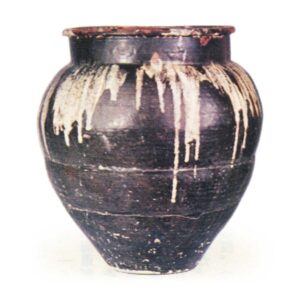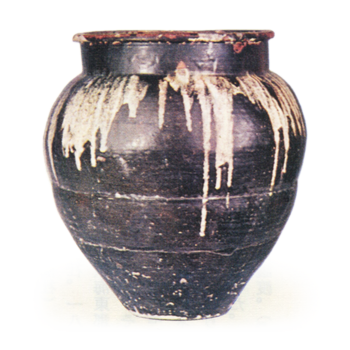
Aizu-yaki, also called Hongo-yaki, is produced mainly in Hongo-cho, Onuma-gun, Fukushima Prefecture (near Aizu-Wakamatsu City).
In February 1647 (Shoho 4), Masayuki Matsudaira (Hoshina family), the feudal lord of the feudal domain, gave him a grant to make pottery for three people. This was the beginning of pottery production in Hongo Village and the beginning of Aizu ware. The products were mainly tea ceremony utensils with a few utilitarian items. Genzaemon died on November 29 of the same year. The following year, his younger brother, Chobei, who had been living in Naganuma, was invited to succeed his brother. Chobei was given an additional allowance for his services in the firing of lime and cold-resistant red tiles, and was given the favor of being named Setoemon (Seto-emon) for generations to come, while also serving as a lime worker in his own right. The most famous of his works is a round, dark tea bowl glazed with blue tea and a little bit of sumi ink and dyed with a crest, which was highly prized as a tea bowl and was a gift from the feudal lord to other families. Setoemon III learned the technique at Takahara Heibei’s factory in Edo (Edo) in 1679 (Enpo 7), which was used by the shogunate. Setoemon IV died on April 18, 1747 (Enkyo 4) at the age of 78. Setoemon Seifusa V died on February 16, 1770. Works up to the fifth generation are known to the public under the name of Furuhongo. Setoemon Narumasa VI died on August 20, 1826, at the age of 77. This generation marked the beginning of Aizu ware porcelain. Setoemon Seiei VII returned to farming and retired in 1870 (Meiji 3), and changed his name to Seto Hajime. He died on March 10, 1893 at the age of 72. The ninth generation was his son Tamon. The above is the main lineage of pottery.
Porcelain] During the Kansei era (1789-1801), a new school of porcelain was born. Ihee Sato, the founder of Ihee Sato, started to produce white porcelain in the An’ei era (1772-81). He left his hometown on September 11, 1797 (Kansei 9) and traveled to Shidoro, Tokoname, Seto, Shigaraki, Shimizu, Awata, Shido, Arita, Hagi and Ibe kilns to explore techniques for a full year before returning to Aizu in August the following year. In April 1800, he built a kiln in the style of Hizen Sarayama, and in October of the same year, he produced his first white porcelain, which was a success 23 years after he had set his sights on white porcelain. He died on October 14, 1842, at the age of 81. The second Togo, whose name was Touichi, died on the 16th day of the first lunar month in 1871 (Meiji 4) at the age of 72. The third Touichi, whose name was Ieichi, died on October 24, 1878, at the age of fifty-five.
The fourth generation was his son Tadashichi. In 1863, Saito Iori, a warrior of the Wakamatsu domain, came to Hongo and completely changed the style of Aizu ware. After the Meiji period, Aizu ware developed into kyusu (teapots), earthenware bottles, and other bagged goods, and produced fine products in the Hizen Mikawachi style, but from around the middle of the Meiji period, it turned to electrical insulators and generally turned to industrial production. The raw materials for Aizu porcelain are mostly quartz rough-faced rocks, and the kiln method and filling method are the special Aizu style, a mixture of the Owari (Aichi Prefecture) and Hizen (Saga and Nagasaki Prefectures) methods. The firing process is characterized by the fact that no unglazed firing is used. (Fukushima Prefecture Ceramics, History of Early Modern Ceramics in Japan)



